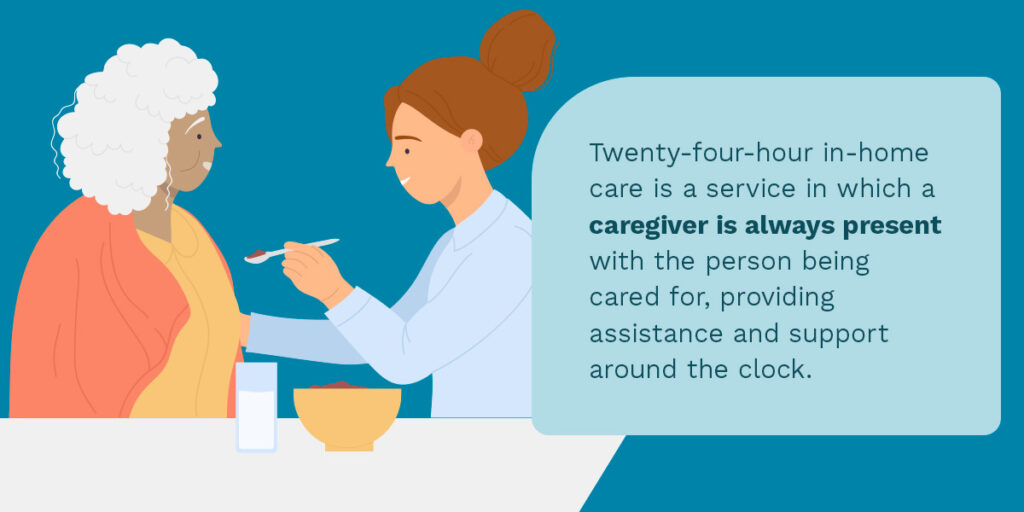24 Hour vs. Live-In Care

Everyone has unique needs when it comes to receiving caregiver assistance as they age and navigate medical conditions. Several types of care are available to meet a range of circumstances, including 24-hour care and live-in care. While these types of care are similar, 24/7 care and live-in care are not the same.
Here we provide an overview of 24-hour versus live-in care and the benefits of each to help families determine the best option for older adults.
What Is 24-Hour Care?
Twenty-four-hour in-home care is a service in which a caregiver is always present with the person being cared for, providing assistance and support around the clock. This type of care is helpful for individuals who have a chronic illness or disability or are recovering from a major surgery or injury.

Around-the-clock care utilizes two to three caregivers who work in shifts, meaning the client will have at least two different assistants coming and going each day. Caregivers are paid an hourly rate, which can become a significant expense. However, the client determines the length of each shift, usually between eight and 12 hours. Additionally, they can decide if and when the caregiver takes breaks.
Having two to three caregivers during each 24-hour period reassures clients that each caregiver is alert and ready to deliver attentive care during their shift.
The caregiver may assist with activities of daily living, such as bathing, dressing and grooming, as well as medication management, meal preparation and other forms of support. The level of care provided can vary based on the client’s needs and can range from basic to specialized medical care.
What Is Live-In Care?
Live-in care is a type of care in which a fully trained caregiver lives with the client in their home. The caregiver supports the client’s needs to keep them comfortable and independent at home.
Live-in caregivers stay in the client’s home with them 24 hours a day for four or five days at a time, depending on the situation. Clients typically have two primary caregivers who split the week and alternate on weekends and holidays. Live-in care incurs a flat-rate daily cost, including rest and sleep breaks, which can amount to half the price of 24-hour care.
Live-in caregivers receive two mandatory breaks during their shifts — eight hours for sleeping and another four-hour break during the day. The client may choose to go unsupervised during caregiver breaks or arrange for another caregiver to cover the time.
With one daily caregiver, the client can benefit from more quality time and fewer interruptions to their daily life. However, individuals who choose live-in care must provide a dedicated bedroom for the caregiver, and the required eight-hour sleep break may leave them without direct supervision at night. Even so, the caregiver is always close by in case of an urgent need.
Live-in care is a popular choice for anyone who wishes to remain in their home while receiving the care and support they need. It’s an excellent option for anyone who wants to maintain independence and stay in familiar surroundings. It’s also a good choice for individuals with complex care needs, as live-in caregivers can provide the one-on-one attention their condition requires.
Hospice vs. Palliative Care
While hospice care and palliative care are related concepts, they differ in a few ways. Each type of care provides physical and psychosocial relief from complex symptoms related to serious illness. Pain and symptom relief are the objectives of each, just with different prognoses and goals of care.
Hospice care provides comfort with no intention of curing the client. It’s designed for a person with a serious illness who is approaching the end of life. Hospice care focuses on the care, comfort and quality of life of those with terminal illnesses expected to have less than six months to live.
Palliative care, on the other hand, is for anyone who has a chronic medical condition. Palliative care provides comfort with or without curative intentions. A key difference between hospice and palliative care is that you can begin palliative care at any point during your illness, while hospice care is typically reserved for the final stages of life.
Hospice care often takes place at home or in home-like hospice residences. If you’re thinking about palliative versus 24-hour care, understand that palliative care occurs in settings such as hospitals, clinics and long-term care facilities and is not round-the-clock. Both hospice and palliative care involve a team of health care professionals who work together to provide care and improve the quality of life for the individual.
The Benefits of 24-Hour Care
Twenty-four-hour care provides many benefits for individuals who need around-the-clock supervision and help with daily activities. These benefits include:
- Reducing the likelihood that a person will become housebound, which can help keep feelings of depression and loneliness at bay.
- Remaining in familiar surroundings so individuals can remain independent and positive, helping reduce anxiety and stress.
- Receiving 24-hour care in multiple environments, including their homes, a personal care center or a nursing facility.
- Helping with daily activities like getting dressed, eating meals and bathing.
- Managing medications and providing wound care.
- Providing older adults with a safe and secure environment, allowing them to receive assistance with their daily needs from caregivers trained to identify and manage any potential safety risks.
- Increasing general well-being and provideing an immediate response to medical or other emergencies.
The Benefits of Live-In Care
Live-in care boasts several of its own benefits, such as:
- With none of the restrictions associated with institutionalized care, live-in care allows individuals to keep their independence and dignity.
- Live-in care enables individuals to maintain the lifestyle they’re used to, keeping beloved pets and attending their usual social activities, which can contribute to a better quality of life.
- Live-in care can reduce the cost of care by offering room and board, especially when the older adult has plenty of space at their current residence.
- Live-in care allows older adults to receive the assistance they need in a private setting, set their own schedule and remain part of their home community.
- Live-in caregivers provide all the same types of care that other home care or home health care workers provide, including personal care, assistance with activities of daily living, companionship and nursing services if trained.
Corewood Care Offers Exceptional 24-Hour Care Services
If you’ve decided that 24/7 care services are best for your aging family member, you can count on the trustworthy professionals at Corewood Care. We provide clients in Bethesda, MD, and surrounding areas with reliable, quality and professional in-home care.
With Corewood Care, older adults enjoy round-the-clock support as needed, 24 hours a day and seven days per week. We’re committed to helping our clients live and age gracefully, and we look forward to meeting the older adult in your family. Contact Corewood Care today to schedule a free assessment.




